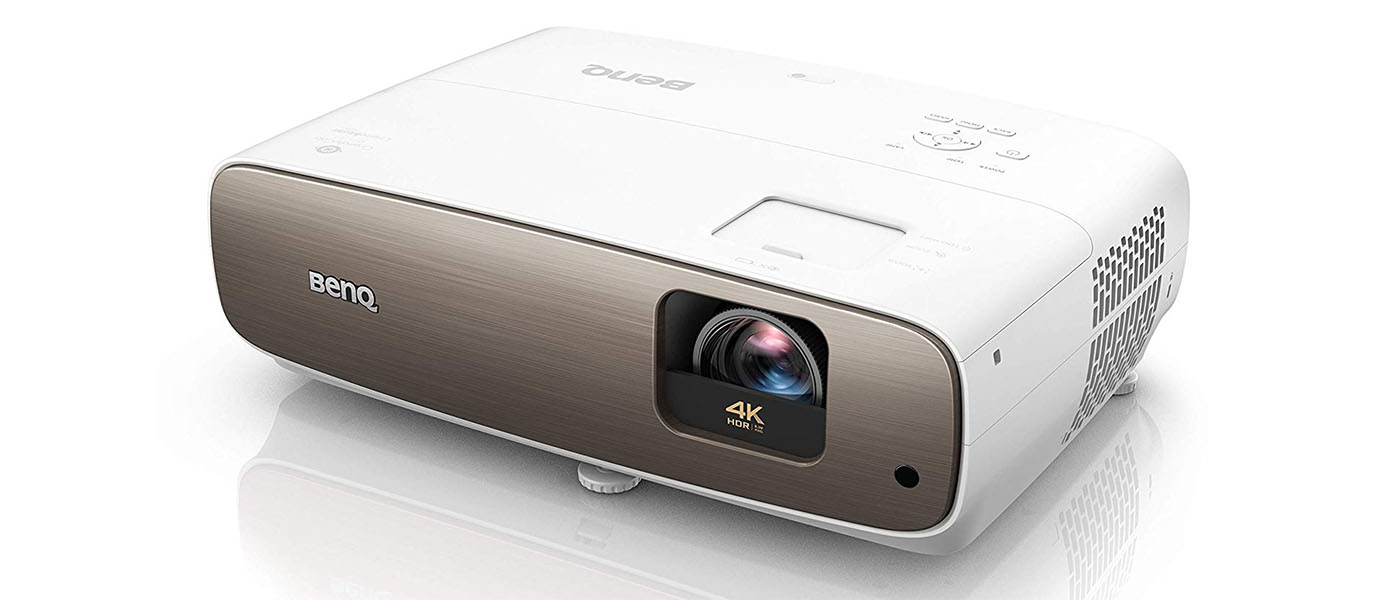But it makes some more serious home theater models too. You’ve already read my reviews of the high-end HT9050 and HT9060 displays. Today, I’m checking out a projector that occupies the middle ground between those and the HT3550, it’s the HT5550. Part of the CinePrime line, it offers Ultra HD resolution, HDR, and DCI-P3 color; one of the first value-priced DLPs to render that larger gamut. It also includes an auto-iris, another rarity in this segment. I’m looking forward to checking it out as it breaks some new ground in the segment and still checks in at the reasonable price of $2499.
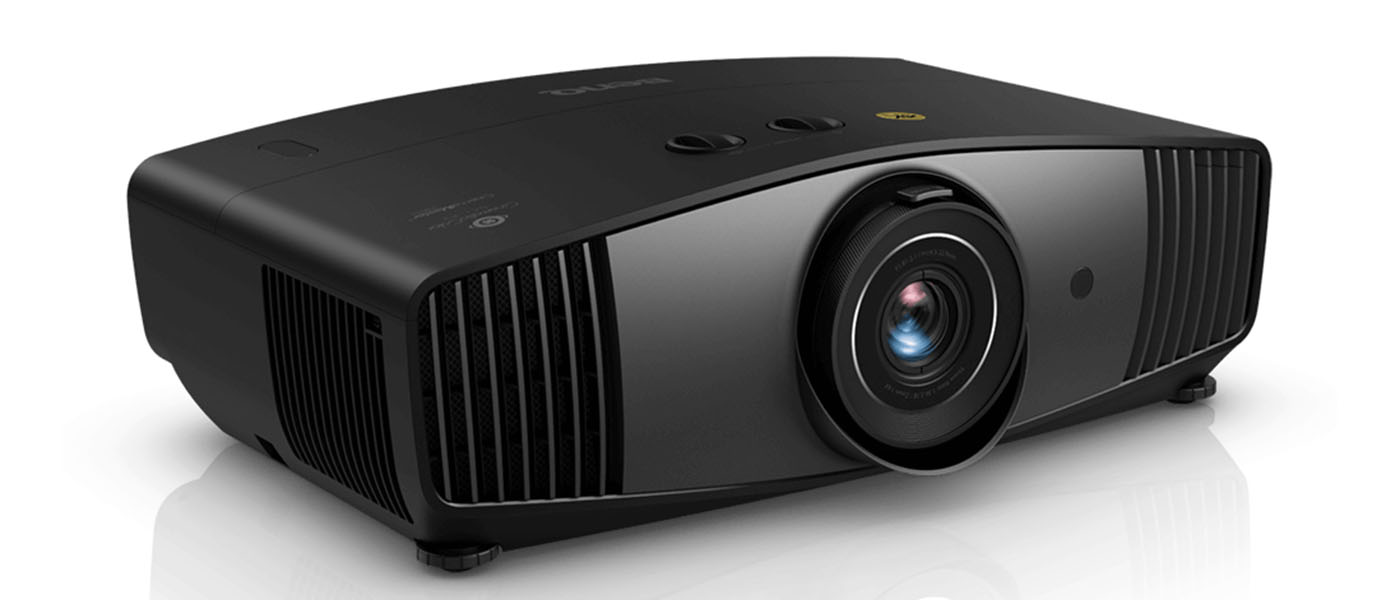
BENQ CINEPRIME HT5550 ULTRA HD DLP PROJECTOR
- True 4K resolution from a single-chip DLP/XPR light engine
- 1800 ANSI lumens
- Generous lens shift and zoom for flexible installation
- BenQ HDR-PRO projector HDR with HDR10 and Hybrid Log Gamma support
- DCI-P3 color gamut
- Factory-certified calibration
Last year, I covered BenQ’s HT2550 Ultra HD Projector which was, and still is, one of the least-expensive Ultra HD projectors available. It delivered a supremely sharp image with excellent accuracy and support for HDR. But one thing was lacking, an extended color gamut. For 2019, BenQ has introduced two new DLP models that cover a goodly portion of that expanded specification, the HT3550 and HT5550 which is my review subject today. Both models are part of BenQ’s CinePrime line of affordable, high-performance home theater projectors.
The HT5550 offers a few more features than the HT3550, mainly in the design of its lens. It sports a generous 60% vertical shift and a 1.6x zoom range which makes it better-suited to permanent home theater installations than the HT3550. That model is more appropriate for coffee tables or as a portable display. Inside though, the hardware is much the same. You get BenQ’s True 4K resolution with 3840×2160 addressable pixels along with HDR-PRO, projector-optimized HDR with support for HDR10 and Hybrid Log Gamma, and DCI-P3 color. Let’s take a closer look.
Type:
single-chip DLP w/XPR
Color wheel:
6x RGBRGB
Native resolution:
1920×1080 shifted to 3840×2160, 16:9 aspect ratio
Color gamut:
Rec.709 and DCI-P3
HDR:
HDR10, Hybrid Log Gamma
Max image size:
300”
Throw ratio:
1.36-2.18
Lens shift:
+/-60% vertical, +/-23% horizontal
Light source:
UHP lamp, 245 watts
Light output (mfr):
1800 ANSI lumens
Lamp service life:
4,000-15,000 hours
Video connections:
2x HDMI 2.0b w/HDCP 2.2
Audio connections:
1x 3.5mm out, 1x TOSLink out
Additional connections:
1x RS232, 1x IR in, 1x 12v trigger, 3x USB, 1x RJ45
Dimensions:
19.4” x 6.6” x 13.7” (WxHxD)
Weight:
14.3lbs
Warranty:
3 years, 180 days lamp
Price:
$2499
Company:
SECRETS Tags:
benq, 4k, cineprime, ultra hd projector, dlp projector, hdr, ultra hd, Projector Review 2019

The CinePrime HT5550 is in the category of Ultra HD DLP projectors that starts with a 1920×1080-pixel single-chip DLP light engine. XPR technology shifts the pixels effectively quadrupling the resolution. The feature is turned on for all signals except 3D which is still shown in 1920×1080. After reviewing many pixel-shifted projectors of the DLP, LCD, and LCoS variety, I have come to regard DLP as the best starting point for this technology. That single chip, combined with a super-fast response, makes it ideally suited to this optical trickery.
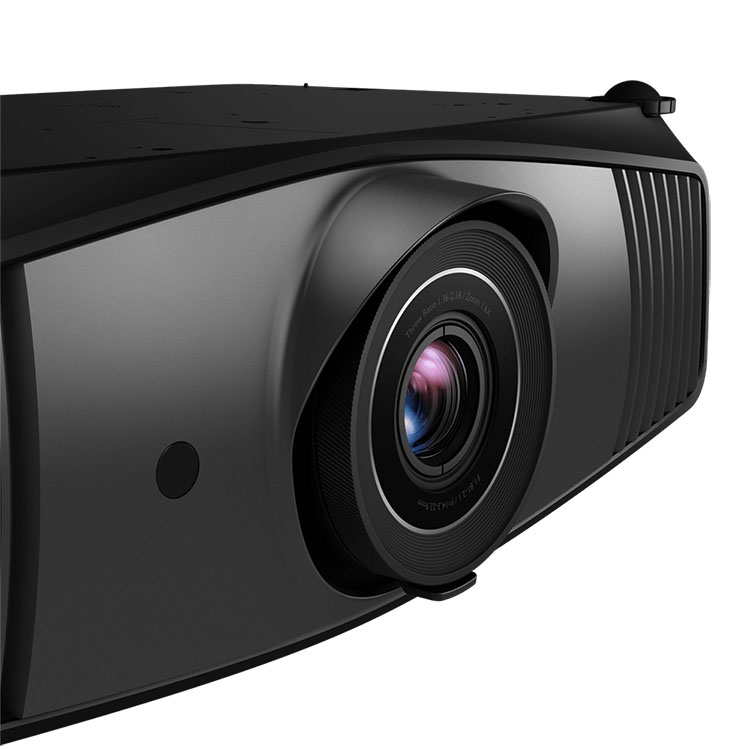
The HT5550’s lens is an all-glass, low-dispersion design which makes the most of its 1800 ANSI lumens and factory-certified color accuracy. The package includes a calibration data sheet showing measurements for both SDR and HDR signals. Speaking of the latter, BenQ addresses the limitations of projector technology with a feature called HDR-PRO. This makes the most of the HT5550’s dynamic range to produce an excellent HDR effect. You’ll still see the very best HDR on an OLED flat panel TV but in the projector world, it doesn’t get much better than BenQ’s carefully-engineered approach.
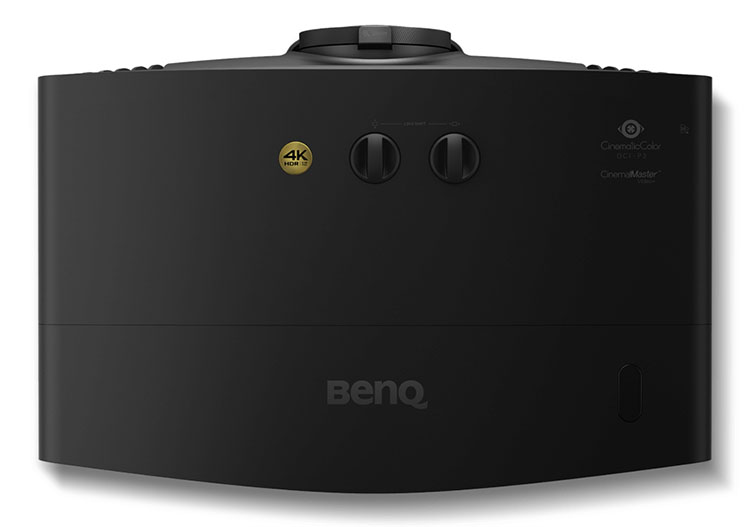
The HT5550 is easily distinguished from the HT3550 by its large black case. Though it is relatively light, it is more substantial than the portable models BenQ is known for. The lens is center-mounted with large rings to adjust focus and zoom. Shift control dials are up top, and all adjustments are very precise. Tweaking image geometry and position only takes a few minutes. With plus-or-minus 60% vertical shift, you can place the projector just about anywhere in relation to the screen. And a 1.6x zoom range accommodates a variety of projection distances. There are few rooms where you can’t make this display work with screen sizes up to 300 inches diagonal.
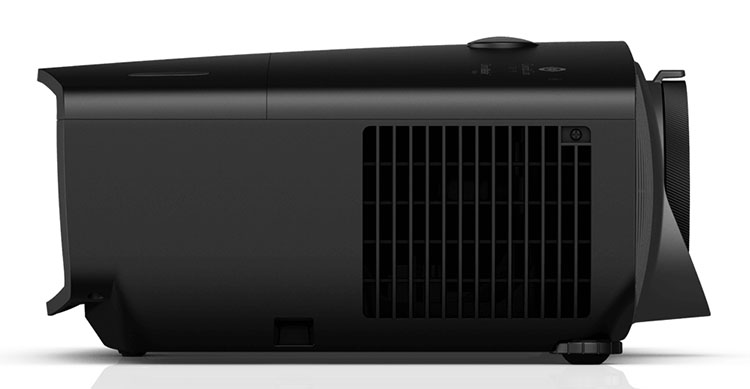
On the right side is a large exhaust port which houses a very quiet fan. There is a bit of light leakage here but not enough to cause issues in a totally dark environment. A good bit of heat comes from it though, so you’ll want to give the HT5550 plenty of room to breathe.

Around back, you’ll find a well-stocked connection panel. There are two HDMI 2.0b ports with HDCP 2.2. You can also use the USB ports to stream media and power connected devices. There are no built-in speakers but a 3.5mm output jack can feed stereo sound to an external amp or powered speakers. Control ports include RS-232, IR in, and a 12v trigger output. Also on this panel are basic menu and source selection controls.

The remote is a nice-sized black handset with a soft orange backlight that comes on with the press of any button. At the top are discrete power keys followed by keystone and menu navigation. On the lower half are direct-access controls for many image controls like picture mode, brightness & contrast, iris, and many others.
BenQ is one of the few manufacturers left that supports 3D content. You can use any aftermarket DLP-Link glasses with the HT5550. I used a pair from Xpand in my testing. Light output is a bit low for really impactful 3D, but crosstalk artifacts are non-existent.
Since the HT5550 offers plenty of lens shift, I set it up on a stand behind my seating for a throw distance of around 12 feet. This allowed me to center the lens on the screen which uses the lowest possible offset, thereby delivering maximum output and sharpness. I avoided the keystone control as it reduces resolution if used in even the smallest measure. The precise zoom and focus rings had my Stewart Filmscreen Studiotek 130 filled with a perfect image in short order.
Both HDMI inputs are version 2.0b with HDCP 2.2 and are full bandwidth, capable of receiving Ultra HD signals up to 60Hz and 10-bits. I did all my viewing with an OPPO UDP-203 and testing with an Accupel pattern generator. For HDR tests, I used an HD Fury Integral simulate HDR10 content.
The menu system is the same one found in BenQ’s current and recent models. The image controls are all in the first sub-menu, logically arranged. There are five picture modes with the default being Cinema Rec.709 for SDR signals. HDR material switches the HT5550 into its single HDR preset which is fully adjustable, independent of the SDR modes.
I created a user mode based on Cinema to perform the calibration. This took all of five minutes as the projector is nearly spot-on out of the box for SDR content. A few tweaks of the RGB sliders and a change to the gamma preset gave me great test results and an excellent image. A note about the Brilliant Color feature – for SDR, it’s best to leave it off. For HDR, I got better results with it turned on. The HDR calibration took a little more work but it was easy to dial in excellent grayscale tracking.
When viewing HDR content, you can alter the HT5550’s brightness with a control called appropriately, HDR Brightness. It raises or lowers the entire luminance curve to better adapt to different content. Most material looks fine on the center zero setting. But a few titles benefitted from the +1 and +2 settings. You can raise or lower the output two steps in each direction.
If you are a 3D movie fan, that mode can also be independently calibrated. Light output is a little weak for really good 3D but there are no artifacts and the effect is pretty good.
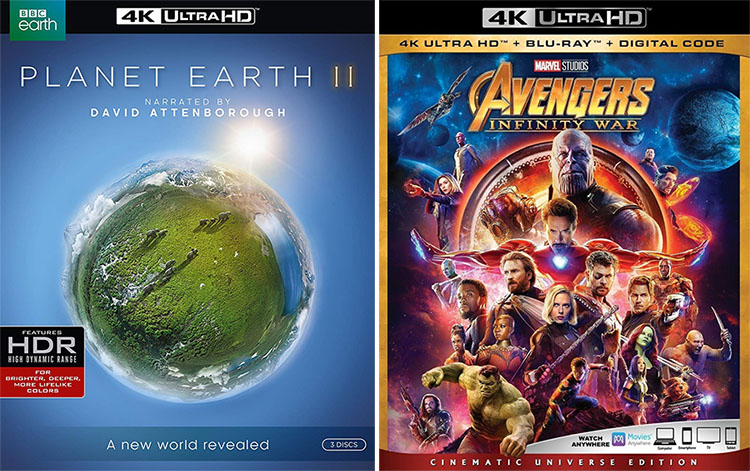
Until 8K becomes a thing, I doubt any video will exceed the quality of Planet Earth II in Ultra HD. It takes the standard to its peak with rich color, razor-sharp detail, and contrast that simply defies easy description. Watching the Grasslands episode on the HT5550 was a revelation of fine detail and texture. One sequence shows a tiny field mouse navigating through a forest of plants looking for food. Seeing this creature enlarged to four feet across in front of me is an amazing experience. Every whisker stands out as an individual element. The golden-brown color of its fur radiated behind a shiny red nose. I can’t imagine a better way to learn about our planet than this. The Cities episode was a great test of black levels which looked impressive. It’s not quite as deep as the best LCoS projectors I’ve seen but it’s startlingly close. Contrast is not an issue here; any viewer would be satisfied.
Avengers Infinity War is a cornucopia of color and contrast. From the strong metallic red of Ironman’s suit to the Hulk’s deep green flesh, vivid tones abound. Detail is always at the forefront with no apparent clipping in the brightest and darkest parts of the picture. This film is full of fast action and flying objects and they are rendered without blur, no matter how rapid things get. Movement like this is DLP’s forte for sure.

Aquaman also has some impressively colorful scenes, especially as Arthur and Mera travel to the kingdom of Atlantis. There are many beautiful creatures glowing against a dark backdrop that almost reminded me of the Pandora landscape from Avatar. BenQ has done a superb job of maximizing the HT5550’s contrast ability with HDR material. You won’t mistake it for a premium OLED panel, but it looks better than just about any projector showing SDR content.
For a trip back to 1987, I watched my new copy of Bumblebee. It’s a great reboot of the franchise and well worth watching. Its trip back in time is portrayed in lots of warm vintage tones with beautiful reds, oranges, and yellows. Color always looked natural with just the right pop to bright highlights and plenty of shadow detail. The textures of the different robots also looked incredibly realistic. Weathered metal and dirty glass looked so good, I could have touched the screen and come away with dirty fingers.
To test the BenQ HT5550’s color accuracy, I measured from the lens with an X-Rite i1 Pro spectrophotometer fitted with a diffuser attachment. Luminance readings were taken with a Spectracal C6 tri-stimulus colorimeter facing a 92” diagonal Stewart Filmscreen Luminesse with Studiotek 130 material, gain 1.3, from a 10-foot distance. Patterns were generated by an Accupel DVG-5000 and controlled with CalMAN, version 5.9.
The HT5550 includes a factory calibration data sheet and for Rec.709 signals, it meets the printed measurements. An SDR calibration will yield a small gain but it’s not necessary to enjoy an extremely accurate image.
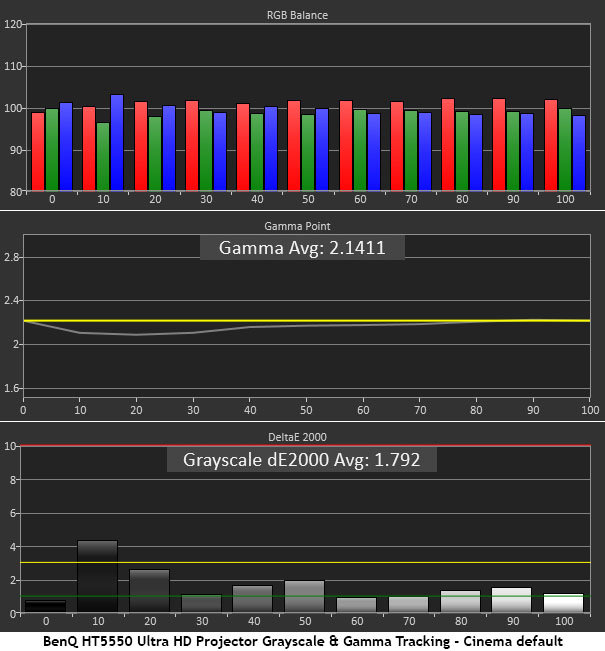
In the default Cinema mode, with Brilliant Color turned off, the HT5550 tracks a D65 grayscale almost perfectly. There’s a small anomaly at 10% brightness but it’s very hard to see. Gamma is just a tad light in the 10-40% range but that too is an extremely small error. With an average error of just 1.792dE, there is no real need for calibration here.
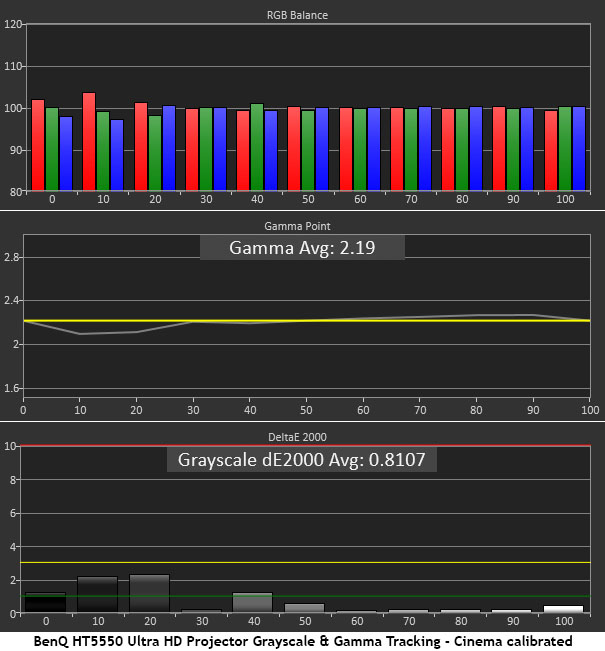
I tweaked the RGB gains and changed the gamma preset from 2.2 to 2.3 which took grayscale and gamma tracking from excellent to near-perfect. Now, all errors are below 3dE with all but 10 and 20% below the 2dE line. Gamma is still a shade light at 10 and 20% but the rest of the range is almost perfectly at 2.2. Now the average error is just .8107dE. It doesn’t get much better than this.
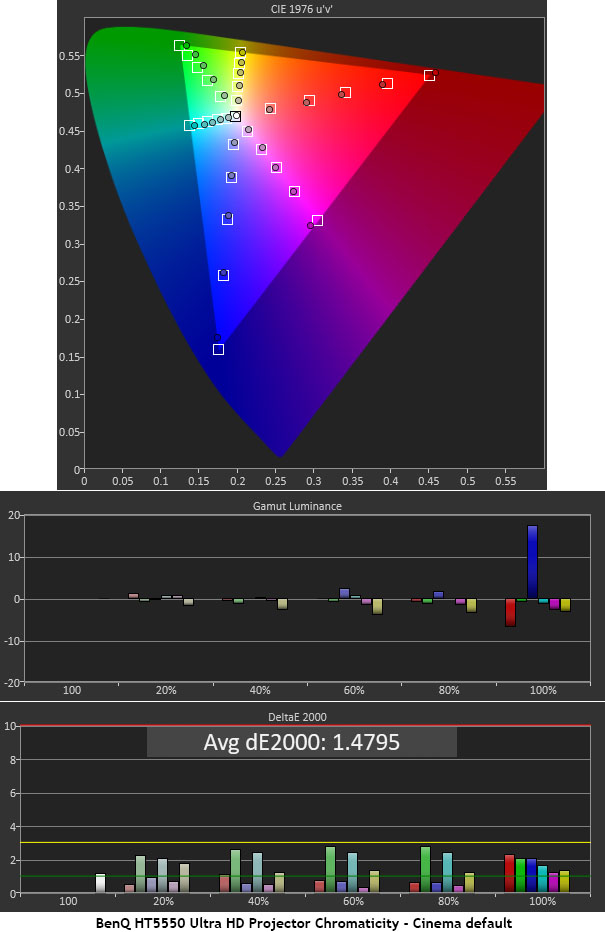
Measuring the HT5550’s default gamut and luminance, there is even less justification for calibration. An average error of 1.4795dE is better than many professional displays that cost far more than this projector. The only thing I want to fix here is the 100% saturation point of the magenta secondary. Every other measurement is inside or in contact with the 1dE box.
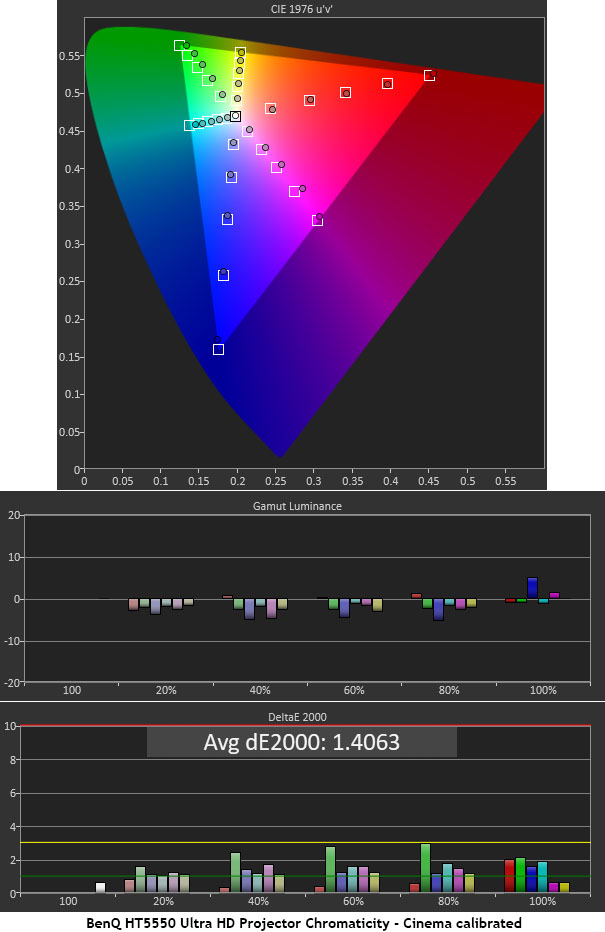
I made a few small changes in the CMS and got nearly the same result as the pre-calibration gamut. The average error is a tad lower but invisibly so. I’m happier with the magenta hue at 100% but honestly, the adjustments were made more to satisfy ego than any real need for improvement. The HT5550 is a reference-quality display with SDR material.
To simulate an HDR10 signal, I added an HD Fury Integral into the signal path. It creates the proper tone map to allow HDR measurements using CalMAN’s special workflow. The HT5550 allows for a full and independent HDR calibration with two-point grayscale, HDR brightness, and color management controls.
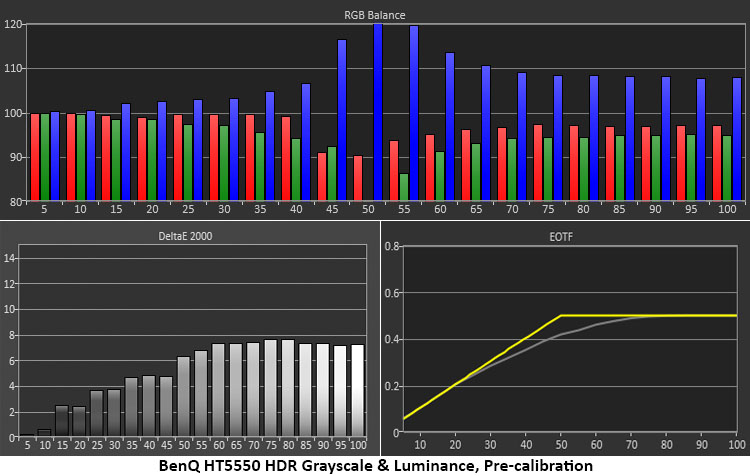
In HDR mode, Brilliant Color has a positive effect, so I left it on for all the tests. The first chart shows grayscale and EOTF tracking without any other adjustments. Wide Color Gamut is on which places a filter in the light path. Tracking is OK up to 35% where things become a bit too cool. The clip point is at 50% where the HT5550 makes a soft transition. This is part of BenQ’s unique approach to projector HDR which they call HDR-PRO. It creates a solid HDR effect with deep blacks and strong highlights even though projectors by nature don’t have the dynamic range of a flat panel. The end result is a good one.
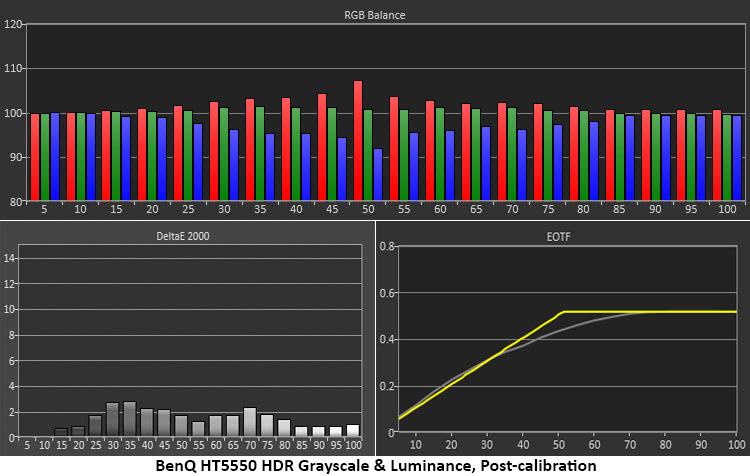
Again, it only took me a few minor tweaks of the RGB gains to improve tracking enough to hide the errors from view. 50% brightness looks warm on the chart, but I couldn’t see the error in test patterns or in actual content. This is excellent performance.

Brilliant Color helps tighten up gamut saturation tracking for all colors. The HT5550 hits most of the inner targets but falls a bit short in the red and green primaries. Magenta is a bit too red as well. I didn’t have enough control range to fix this error. While the gamut is larger than Rec.709, it doesn’t quite hit the full DCI-P3 spec.

To see below-black and above-white information, you must set HDMI Range to full in the OSD. This will require a recalibration of the brightness and contrast sliders. I preferred to use the HT5550’s full dynamic range and clip the out-of-range material. RGB signals will provide the best possible resolution as my component format tests showed roll-off of the one-pixel chroma burst patterns. For those still watching DVDs and interlaced content, the projector fails both the 2:2 (video) and 3:2 (film) tests. The 24p cadence is processed correctly with frames repeated four times for a 96Hz refresh. The jaggies test was excellent with the near-perfect rendering of the sailing ship clip. No anti-aliasing or edge enhancement was visible. To avoid artifacts, one should set the Pixel Enhancer 4K slider in the Cinema Master menu to zero.
All luminance values are expressed here in nits, also known as candelas per square meter (cd/m2). For those needing a frame of reference, 1fL equals 3.43 nits, or 1 nit equals .29fL.
The HT5550 puts out enough light to fill a good-sized screen in a large theater. On my 92-inch Stewart, I saw 117.2936 nits peak, .1736 nit black, and a native contrast ratio of 675.5:1 after calibration. This is without the iris engaged and the bulb on Normal brightness.
Using the iris makes a huge impact on the dynamic range. With no other adjustments, peak output is 100.9582 nits with .027 nit black, and a contrast ratio of 3733.8:1. If you’d rather use SmartEco instead of the iris, the values are 115.41 nits peak, .0809 nit black, and 1426.5:1 contrast.
Maximum output comes from the Bright picture mode where you’ll see 186.3182 nits peak, .0339 nit black, and 5488.8:1 contrast. Don’t be tempted by this high ratio. It comes at the expense of significant detail clipping in both highlight and shadow areas.
In HDR mode, the peak output is 106.7733 nits with a black level of .0252 nit and 4241:1 contrast. 3D signals measured through the glasses yield 13.2458 nits peak, .0048 nit black, and 2766.9:1 contrast. This is with the iris engaged and bulb on Normal power. 3D crosstalk is a scant .02%, completely invisible.

For $2499, the BENQ CINEPRIME HT5550 offers performance and features comparable to much more expensive projectors. Its DLP clarity and motion processing are superior to three-chip LCD and LCoS designs.
- Clear, bright picture
- Excellent contrast with the auto-iris engaged
- Accurate Rec.709 color
- Solid build quality
- Plenty of lens shift and zoom for flexible installation
- Larger DCI-P3 color gamut
- Brighter 3D
I have yet to meet a BenQ projector I didn’t like. Their DLP displays offer some of the best price/performance ratios in the business. The CinePrime HT5550 is a, well, prime example of this. For $2499, you get a DLP projector with superb clarity that rivals any native 4K model and beats them handily when things get moving on screen. Slow camera pans are the stuff of show demos but when one sits down to watch an actual movie, DLP keeps things blur-free better than LCD or LCoS, no matter how many pixels there are behind the lens.
This is nothing new for BenQ; what is new however is the HT5550’s wider color gamut and improved HDR. I enjoyed greater perceived contrast with Ultra HD discs than I did when watching them on the HT2550. And the extended color makes a real impact on the presentation. It comes up a little short of spec in the red and green primaries but honestly, I didn’t find this to be a major flaw. If you’re considering upgrading your HT2550, the HT5550 might be worth considering.
Comparisons to the new HT3550 are inevitable. Essentially, the two projectors are the same except for the lens. The HT5550 offers more shift and zoom making it more suitable for use in a dedicated home theater. While the HT3550 can fill that role, its shorter throw and smaller shift make it more appropriate for informal setups where one might put the projector on a coffee table. For my environment, I’d choose the HT5550.
BenQ’s DLPs get better and better with each new model. The CinePrime HT5550 continues that evolution and receives my highest recommendation.


